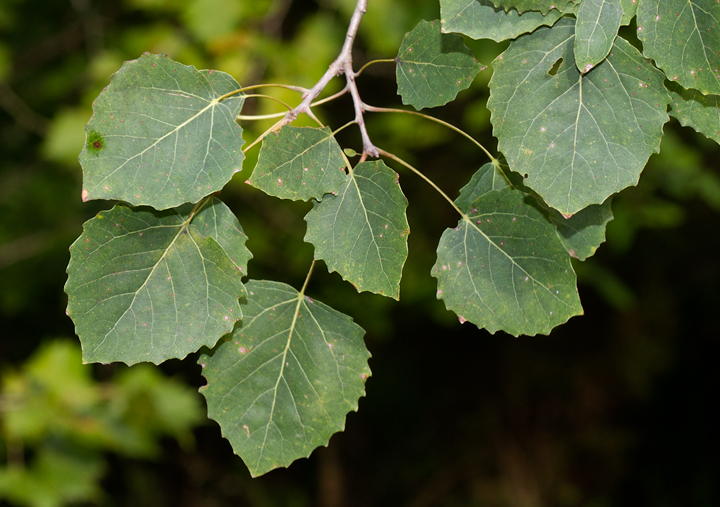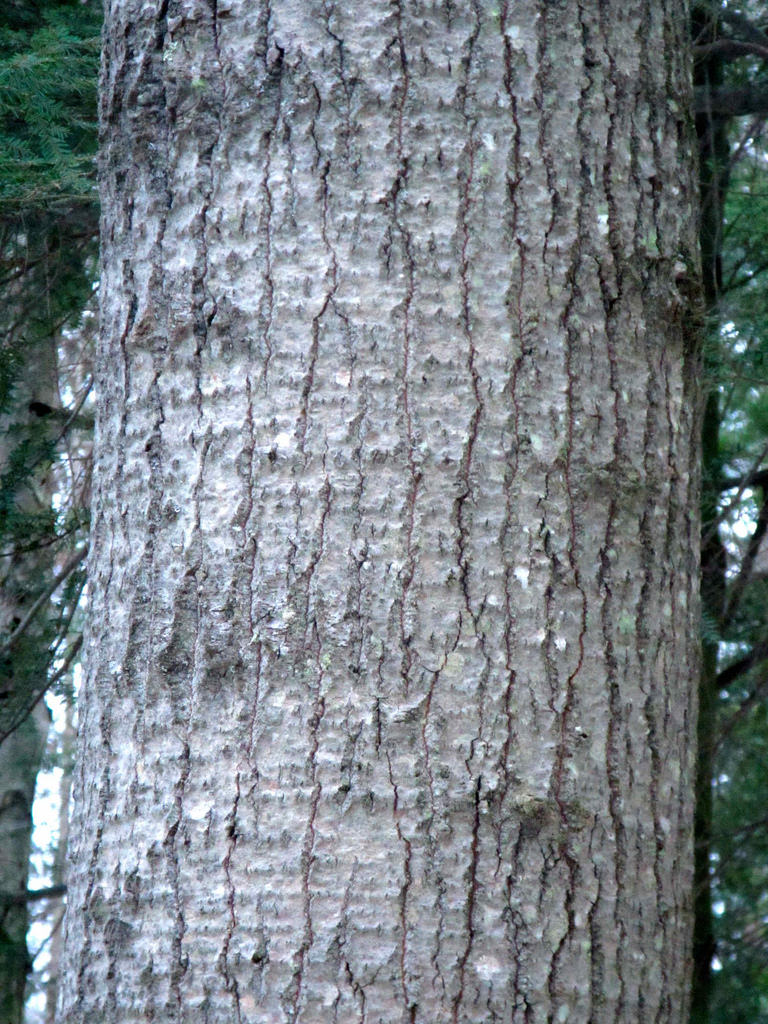Bigtooth Aspen
Populus grandidentata Michx.
Description
Bigtooth aspen, also known as largetooth aspen, poplar, or popple, is a member of the willow family (Salicaceae) ¹. This tree grows 50 to 100 feet tall, at most 20 inches in diameter, and only lives to about 50 years. Young trees have thin yellowish green bark, and as the tree ages ridges and furrows develop in the dark and darken in color ². Leaves are oval in shape and are arranged alternately around branches. They grow around 2 to 4 inches long and 1.75 to 3.5 inches wide. The leaves are covered in small hairs that eventually fall off as the leaf matures. The tree is named after its uniquely large toothed edges found on the leaves ³. Tan flowers develop as drooping catkins 2 -3 inches long at 10 years of age. Male and female flowers are on different trees, so they must be pollinated through wind dispersing gametes in the early summer. Seeds are tiny with tufts of silky hairs enabling wind dispersal ¹. The tree mainly reproduces through adventitious stems called suckers, essentially creating many clones of itself 1.
 Leaves of bigtooth aspen. @ B. Hubick, 2012. Maryland Biodiversity Project 5.
Leaves of bigtooth aspen. @ B. Hubick, 2012. Maryland Biodiversity Project 5.

Trunk of bigtooth aspen. @ Boyer and McDowell, 2018. Maryland Biodiversity Project 5.
Distribution
Bigtooth aspens typically grow in sunny and dry areas 6. They are native to northeastern and north-central locations in the United States and southeastern Canada. Although they are not shade tolerant or flood resistant, they are able to grow in a variety of soil conditions including sands and clays. Bigtooth aspens grow best on flat ground with well drained soils in forests containing other aspens or poplars¹. Although bigtooth aspen is found across Maryland, it is most common in Garrett, Frederick, Howard, and Anne Arundel counties 5.

Native range of bigtooth aspen. USDA ¹ .
Wildlife Importance
Bigtooth aspen suckers are a major food source for moose and deer during the wintertime. Healthy deer populations are associated with a widespread bigtooth aspen population¹. Birds and other small mammals collect seeds, buds, and catkins for food ². These trees also provide habitat for many birds, mammals, and insects. Beavers eat the bark, branches and leaves 7 Flowers attract many butterflies, including the Eastern Tiger Swallowtail and Viceroy. In areas affected by fire, bigtooth aspens are often one of the first trees introduced into the area for revegetation due to their ability to rapidly grow and put out suckers 6.
Economic Importance
The wood is mainly used for pulp due to its light color and soft nature. Wood can also be used for structural panels, log homes, matches, chopsticks, and ladders. Supplemental cattle feed and fuel utilize pellets made from aspen bark 7.
Threats
Due to its very thin bar, this tree is greatly threatened by wildfires. Fires are not only able to easily destroy the tree’s cambium, but it can also create disease entry pathways. Similarly, human and beaver girdling is also harmful¹. One of the largest threats to bigtooth aspens are hypoxylon cankers, a disease that develops under the bark causing the sapwood to decay 8. Other diseases include heart rot, shepard’s crook, and root decay. Poplar borers (Saperda calcarata) bore through the tree bark, potentially causing stems to break off and disease to enter if boring is extreme. Grazing from deer and rabbits is rarely a problem because the thinning of trees can be beneficial with limited resources¹.
Interesting Facts
- The Latin name Populus translates to Poplar, and grandidentata is “having big teeth” 4.
- Bigtooth aspen was first discovered by French botanist Andre Michaux (1746-1802), who travelled across the United States collecting plant species 4.
- One bigtooth aspen can produce 1.5 million seeds during its lifetime 9.
- The tallest bigtooth aspen in Baltimore County is located at Patapsco Valley State Park. It stands at 100 feet tall with a circumference of 55 inches. The tallest bigtooth aspen in Maryland stands 121 feet tall, has a circumference of 77, and is located in Rocks State Park in Harford County10.
References
- USDA-Forest Service, Silvics, Volume 2: Populus grandidentata
- Iowa State University, Extension and Outreach: Bigtooth aspen
- Minnesota Wildflowers: Populus grandidentata
- Trees and Shrubs of the Eloise Butler Wildflower Garden: Bigtooth aspen
- Maryland Biodiversity Project: Bigtooth aspen
- Lady Bird Johnson Wildflower Center: Populus grandidentata
- USDA-Forest Service, Fire Effects Information System: Populus grandidentata
- Texas A & M Agrilife Extension: Hypoxylon canker of oaks
- Virginia Tech Dendrology: Populus grandidentata
- Maryland Big Trees
Contributed by A. Welsh
